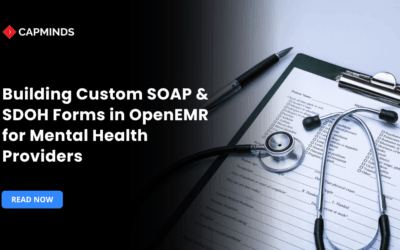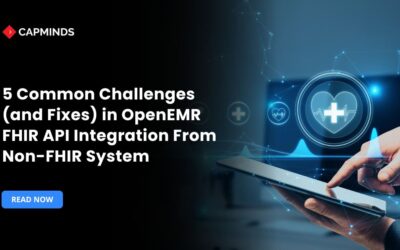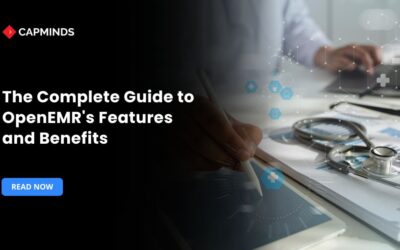Reengineering EHR Infrastructure at Scale: The Strategic Advantage of OpenEMR
Healthcare organizations are adapting to upgrade legacy technology, improve patient care, and meet regulatory obligations. The EHR infrastructure is at the peak of this transition, providing the digital backbone for clinical processes, patient engagement, billing, and analytics.
OpenEMR, an open-source EHR platform, provides a significant strategic advantage for healthcare providers wishing to upgrade or expand their EHR capabilities. Using a free, community-driven codebase enables enterprises to customize solutions, reduce costs, and accelerate innovation.
This blog explains why reengineering your EHR infrastructure for OpenEMR at scale is not only feasible but also transformational.
The Challenge of EHR at Scale
1. Escalating Costs and Vendor Lock‐In
Commercial EHR licensing, implementation fees, and maintenance can cost millions for large hospital systems. Proprietary platforms can lead to budgetary constraints and hinder innovation by requiring rigid upgrade routes and recurrent per-user costs.
2. Limited Customization
Many off-the-shelf EHR solutions offer limited customizing choices. Developing unique clinical workflows or specific modules, like cancer procedures or multi-site behavioral health services, can be costly and time-consuming.
3. Interoperability Barriers
Data silos and proprietary data formats make it difficult to exchange patient records between systems, limiting care coordination and population health programs. Additional middleware and third-party integration services are frequently required in order to use HL7 FHIR APIs and comply with ONC’s Cures Act standards.
4. Scalability and Performance
As patient volumes and telehealth develop, EHR systems must handle increased transaction loads, high availability, and real-time analytics. Many legacy systems fail to handle peak demand, causing disruption that directly impacts patient care.
Related: Your Strategic Guide to Scaling EHR, Interop, and RCM Systems in 2025
Why OpenEMR?
OpenEMR is a popular open-source EHR platform with a global contributor base, certifications, and multilingual support. Here’s how OpenEMR handles scaling challenges.
1. Cost-Effectiveness
Open-source license eliminates per-user and per-site fees, significantly reducing initial and continuing expenditures. Using in-house or contracted developers instead of proprietary vendor consultants helps control implementation and customization expenses.
2. Customization and Extensibility
Plugins and modules enhance functionality by integrating telehealth, patient portals, and specialty-specific templates. You can customize every part of the UI, data model, and business logic to fit your organization’s workflows, as it provides full code access to all.
3. Community and Support
Various physicians, developers, and integrators provide features, issue fixes, and security patches. Certified service providers provide implementation, hosting, and support, combining open-source flexibility with enterprise-level expertise.
4. Interoperability and Compliance Standards
Ensure compliance by supporting HL7, FHIR, CCD/CCDA, and DICOM imaging standards for easy data sharing. ONC certification ensures compliance with the US government criteria for meaningful use and interoperability.
5. Scalability and Performance
Deploy on AWS, Azure, or private OpenStack clouds using containers such as Docker, Kubernetes to provide auto-scaling and high availability. Supports MySQL/MariaDB with performance optimization, read replicas, and clustering for high data volumes.
Best Practices for Reengineering at Scale
1. Comprehensive Assessment
Map out current workflows, pain points, and integration requirements. Identify modules that may be replaced as-is and those that require complete redesign.
2. Phased Migration Strategy
The pilot phase begins with a single department or clinic that validates templates, migrates data, and trains users. Incremental rollout spreads to new sites, learning and optimizing between them.
3. Data Migration and Cleansing
Use ETL tools to extract old records, convert formats, and load them into OpenEMR. Clean and de-duplicate patient information and standardize coding systems such as ICD-10 and SNOMED CT.
4. Reliable Integration Layer
Use an API gateway or ESB such as Mirth Connect to route real-time messages between laboratories, imaging, billing, and external health information exchange.
5. Automated Testing and CI/CD
Set up continuous integration pipelines to execute unit tests, security scans, and performance benchmarks on new code pushes.
6. User Training and Change Management
Create role-based training modules, peer mentorship programs, and superuser champions to increase adoption.
7. Ongoing Maintenance and Governance
To give updates, module requests, and community contributions top priority, establish a governing board made up of IT, clinical, and compliance stakeholders.
Related: Cut EHR Licensing Costs by 60%: OpenEMR vs. Legacy Systems for Enterprise-Scale Operations
Unlock Enterprise-Grade EHR Scalability with CapMinds
CapMinds offers a dedicated EHR Scalability Service designed to ensure your electronic health record system grows seamlessly alongside your organization. Our experts help you:
- Assess & Plan a scalable architecture tailored to your current and future user loads.
- Optimize Infrastructure using cloud-native strategies, load balancing, and database tuning.
- Implement Best Practices for concurrency, caching, and monitoring to prevent performance bottlenecks.
- Ensure Security & Compliance every step of the way, from design through deployment.
Whether you’re preparing for regional expansion, integrating new facilities, or simply aiming to deliver consistently fast access for clinicians and staff, CapMinds has the proven experience to make it happen.
Ready to scale without compromise?
Contact CapMinds today to discuss how our EHR Scalability Service can support your growth ambitions and keep your system performing at its best.




